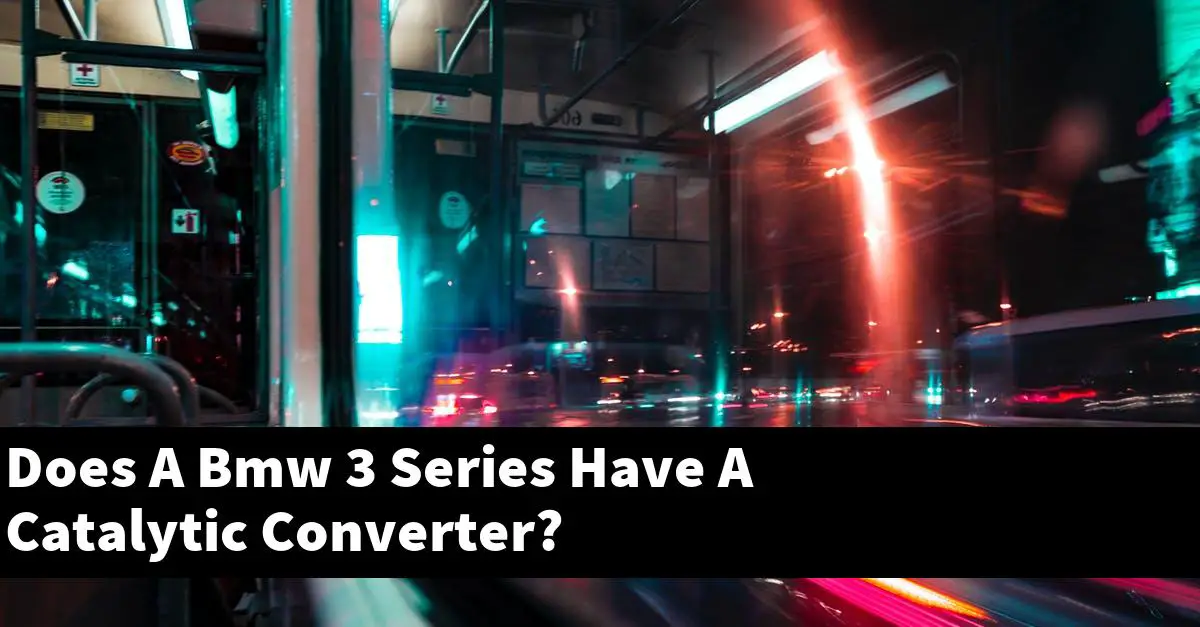The BMW 3 series is a compact executive car produced by the German automaker BMW since May 1975. It is the successor to the 02 Series and has been produced in seven different generations. The third generation of the BMW 3 series was produced from 1987-1991 and was equipped with a catalytic converter.
Where is the catalytic converter located in a BMW?
The catalytic converter is located on the exhaust pipe of a BMW.
How many catalytic converter does a BMW have?
The catalytic converter on a BMW typically has three or four catalytic converters.
Can a BMW run without a catalytic converter?
It depends on many factors, including the make and model of the car, the engine type, and the driving style. However, most modern cars equipped with engines that use fuel injection (i.e. gasoline, diesel, or hybrid) do not require a catalytic converter.
In these types of engines, the fuel is injected directly into the engine cylinders, and the catalytic converter only helps to reduce harmful emissions. For example, a BMW 3 Series without a catalytic converter would not be able to run on gasoline.
Can a bad BMW cat reduce performance?
It depends on the particular make and model of BMW car, as well as the individual driver’s driving habits. However, a poorly maintained or unkempt BMW cat may result in decreased fuel efficiency, decreased acceleration and braking performance, and decreased handling.
Consequently, a BMW driver who is concerned about maintaining peak performance may want to take care of their cat to ensure optimal performance.
Are BMW catalytic converters necessary?
BMW’s use of catalytic converters in their vehicles has been controversial in recent years. Some people feel that they are not necessary, while others feel that they are important for the emissions performance of the vehicles.
Catalytic converters work by breaking down harmful emissions from the vehicle. They are typically located in the exhaust pipe and are responsible for removing a large percentage of the emissions from the engine.
The primary concern with the use of catalytic converters is that they can create “tailpipe” emissions. These emissions are released directly from the vehicle and can be harmful to the environment.
There are two types of catalytic converters: mechanical and electronic. Mechanical converters work by using a metal screen to trap and break down the emissions.
Electronic converters use a sensor to detect the type of exhaust gas and then alter the operation of the catalyst to produce the best emissions.
There are a number of factors that can affect the emissions performance of a catalytic converter. These include the type of fuel used, the age of the converter, and the condition of the exhaust system.
The use of catalytic converters has been controversial in recent years. Some people feel that they are not necessary, while others feel that they are important for the emissions performance of the vehicles.
The primary concern with the use of catalytic converters is that they can create “tailpipe” emissions. These emissions are released directly from the vehicle and can be harmful to the environment.
There are a number of factors that can affect the emissions performance of a catalytic converter. These include the type of fuel used, the age of the converter, and the condition of the exhaust system.
What is a catalytic converter and how does it work?
A catalytic converter is a device that cleans exhaust gases from the engine. Catalytic converters are made up of a number of different parts including a metal catalyst, a metal support, and a housing.
The catalyst is a metal that responds to heat and pressure to break down pollutants into less harmful substances. The metal support helps hold the catalyst in place and the housing protects it from the environment.
When the engine is running, the gases passing through the converter are heated up and the metal catalyst becomes active. This breaks down the pollutants into less harmful substances, which are then released into the air.
How many catalytic converters does a BMW have?
A BMW has anywhere from two to six catalytic converters. Each converter helps reduce the harmful emissions from the engine.
Catalytic converters are important because they help reduce the levels of nitrogen oxide and hydrocarbons in the exhaust.
Does a BMW have a catalytic converter?
A catalytic converter is a device that helps reduce the amount of harmful emissions from a vehicle. BMWs typically have a Catalytic Converter System, which helps reduce the amount of harmful emissions from the engine.
What is a BMW catalyzer and how does it work?
A BMW catalyzer is a device that helps to reduce the amount of harmful emissions from a car. It does this by breaking down the pollutants that are released when the car is in use.
The catalyzer works by converting the pollutants into harmless gases.
How many catalytic converters does a BMW 325i have?
A catalytic converter is an emission control device that converts harmful pollutants into less harmful gases. A BMW 325i has 3 catalytic converters.
Conclusion
The BMW 3 Series does have a catalytic converter. This is a device that helps to convert exhaust gases into less harmful substances.


